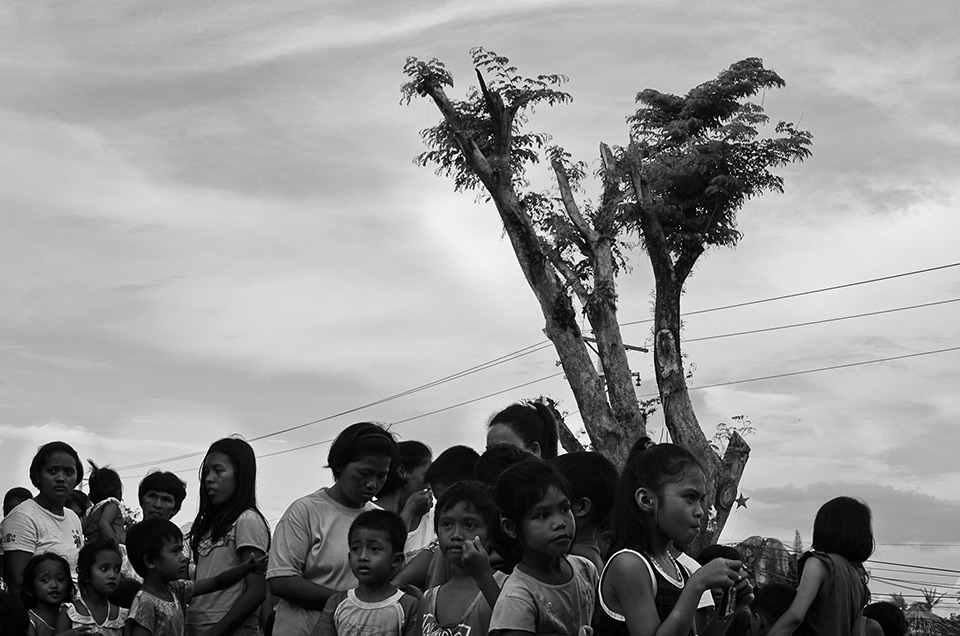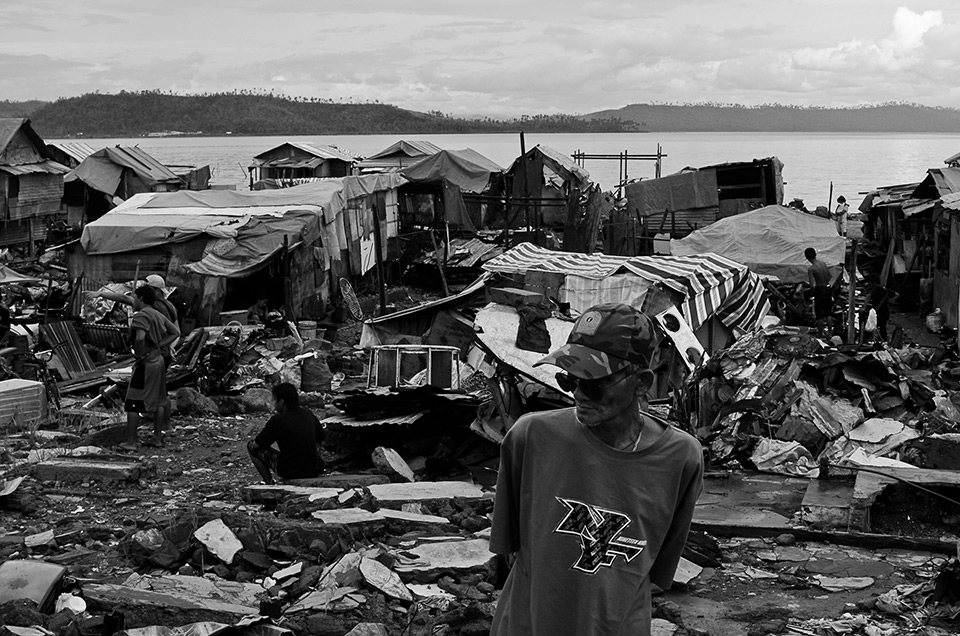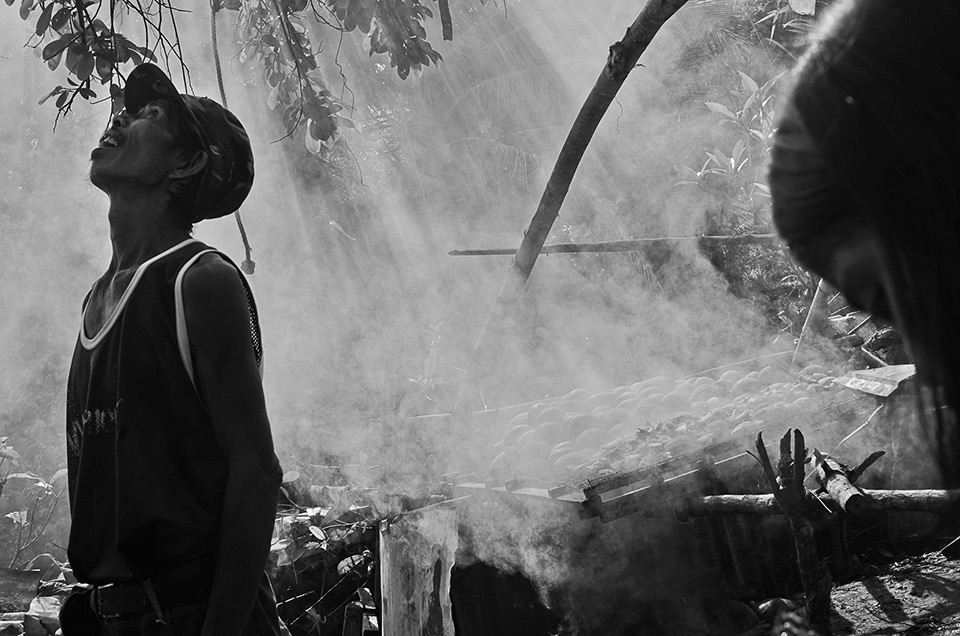 Like the narra tree rising above them, these women and children withstood the typhoon.
Like the narra tree rising above them, these women and children withstood the typhoon. Newly built homes made of scrap material are seen in the coastal barangay of Anibong, where the water reached approximately 20 feet high.= during the storm surge.
Newly built homes made of scrap material are seen in the coastal barangay of Anibong, where the water reached approximately 20 feet high.= during the storm surge.
 Residents of Bgy. Anibong.
Residents of Bgy. Anibong. A child walks by newly built homes in debris-laden Bgy. Anibong.
A child walks by newly built homes in debris-laden Bgy. Anibong.
 A resident contemplates the wreckage surrounding her new home.
A resident contemplates the wreckage surrounding her new home. Unidentified bodies numbering 1,500 are left to rot in a mass grave in Bgy. Suhi.
Unidentified bodies numbering 1,500 are left to rot in a mass grave in Bgy. Suhi. Edito Mamita, 49, talks about his experience during the height of typhoon Yolanda.
Edito Mamita, 49, talks about his experience during the height of typhoon Yolanda.
 A mother and her child living in a tent provided by an NGO.
A mother and her child living in a tent provided by an NGO. Pleas for help are sprayed on the hull of a ship that was washed ashore in Anibong.
Pleas for help are sprayed on the hull of a ship that was washed ashore in Anibong.
 A bowl of warm adobo is a well-deserved treat for many survivors who have been living on canned relief goods. The feeding program was conducted by the Art Relief Mobile Kitchen at sitio Salvacion, Bgy. Tigbao.
A bowl of warm adobo is a well-deserved treat for many survivors who have been living on canned relief goods. The feeding program was conducted by the Art Relief Mobile Kitchen at sitio Salvacion, Bgy. Tigbao. Life goes on as people rebuild their houses and lives.
Life goes on as people rebuild their houses and lives. Survivors scavenge through the debris along the coast among ships that were swept inland by the storm surge.
Survivors scavenge through the debris along the coast among ships that were swept inland by the storm surge.
 The bayanihan spirit is alive among the people of Tacloban.
The bayanihan spirit is alive among the people of Tacloban.
 Residents search through the debris for anything that can be sold to make a few pesos.
Residents search through the debris for anything that can be sold to make a few pesos.
 A scavenged scrap of GI sheet means food for this boy and his family.
A scavenged scrap of GI sheet means food for this boy and his family.
 A man relaxes in the ruins of his home in Anibong.
A man relaxes in the ruins of his home in Anibong.
 Many residents, like this man, have begun constructing shanties on the very spot where their houses once stood.
Many residents, like this man, have begun constructing shanties on the very spot where their houses once stood.
 Strong winds destroyed houses in the hilly village of Sitio Salvacion in Bgy. Tigbao.
Strong winds destroyed houses in the hilly village of Sitio Salvacion in Bgy. Tigbao.
 The spirit of Tacloban is alive.
The spirit of Tacloban is alive.
 A local vendor sells flowers in the busy market area of Tacloban.
A local vendor sells flowers in the busy market area of Tacloban.
 A woman enjoys a light moment while foraging for things she could sell.
A woman enjoys a light moment while foraging for things she could sell.
 Salvador Carato of Bgy. Diit gathers fallen coconuts to be processed into copra.
Salvador Carato of Bgy. Diit gathers fallen coconuts to be processed into copra.
 Like the narra tree rising above them, these women and children withstood the typhoon.
Like the narra tree rising above them, these women and children withstood the typhoon. Newly built homes made of scrap material are seen in the coastal barangay of Anibong, where the water reached approximately 20 feet high.= during the storm surge.
Newly built homes made of scrap material are seen in the coastal barangay of Anibong, where the water reached approximately 20 feet high.= during the storm surge.
 Residents of Bgy. Anibong.
Residents of Bgy. Anibong. A child walks by newly built homes in debris-laden Bgy. Anibong.
A child walks by newly built homes in debris-laden Bgy. Anibong.
 A resident contemplates the wreckage surrounding her new home.
A resident contemplates the wreckage surrounding her new home. Unidentified bodies numbering 1,500 are left to rot in a mass grave in Bgy. Suhi.
Unidentified bodies numbering 1,500 are left to rot in a mass grave in Bgy. Suhi. Edito Mamita, 49, talks about his experience during the height of typhoon Yolanda.
Edito Mamita, 49, talks about his experience during the height of typhoon Yolanda.
 A mother and her child living in a tent provided by an NGO.
A mother and her child living in a tent provided by an NGO. Pleas for help are sprayed on the hull of a ship that was washed ashore in Anibong.
Pleas for help are sprayed on the hull of a ship that was washed ashore in Anibong.
 A bowl of warm adobo is a well-deserved treat for many survivors who have been living on canned relief goods. The feeding program was conducted by the Art Relief Mobile Kitchen at sitio Salvacion, Bgy. Tigbao.
A bowl of warm adobo is a well-deserved treat for many survivors who have been living on canned relief goods. The feeding program was conducted by the Art Relief Mobile Kitchen at sitio Salvacion, Bgy. Tigbao. Life goes on as people rebuild their houses and lives.
Life goes on as people rebuild their houses and lives. Survivors scavenge through the debris along the coast among ships that were swept inland by the storm surge.
Survivors scavenge through the debris along the coast among ships that were swept inland by the storm surge.
 The bayanihan spirit is alive among the people of Tacloban.
The bayanihan spirit is alive among the people of Tacloban.
 Residents search through the debris for anything that can be sold to make a few pesos.
Residents search through the debris for anything that can be sold to make a few pesos.
 A scavenged scrap of GI sheet means food for this boy and his family.
A scavenged scrap of GI sheet means food for this boy and his family.
 A man relaxes in the ruins of his home in Anibong.
A man relaxes in the ruins of his home in Anibong.
 Many residents, like this man, have begun constructing shanties on the very spot where their houses once stood.
Many residents, like this man, have begun constructing shanties on the very spot where their houses once stood.
 Strong winds destroyed houses in the hilly village of Sitio Salvacion in Bgy. Tigbao.
Strong winds destroyed houses in the hilly village of Sitio Salvacion in Bgy. Tigbao.
 The spirit of Tacloban is alive.
The spirit of Tacloban is alive.
 A local vendor sells flowers in the busy market area of Tacloban.
A local vendor sells flowers in the busy market area of Tacloban.
 A woman enjoys a light moment while foraging for things she could sell.
A woman enjoys a light moment while foraging for things she could sell.
 Salvador Carato of Bgy. Diit gathers fallen coconuts to be processed into copra.
Salvador Carato of Bgy. Diit gathers fallen coconuts to be processed into copra.